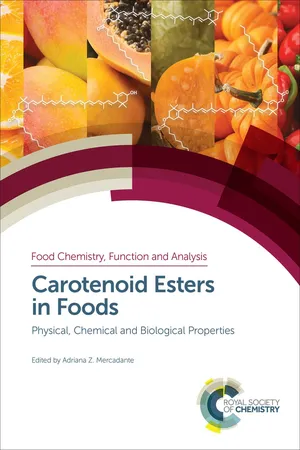
Carotenoid Esters in Foods
Physical, Chemical and Biological Properties
- 466 pages
- English
- ePUB (mobile friendly)
- Available on iOS & Android
About This Book
Carotenoids are found in some food plants, flowers and animals, in free form and also esterified with fatty acids. Recent research has concentrated on the extent of carotenoid esters in these sources, how to assess their presence and the amount available for potential health effects. Focusing on the occurrence and assembly in foods, biosynthesis, analytical methods for identification and quantification, dietary intake and metabolism, the most recent research is represented and a balanced overview of what is known about carotenoid esters is provided.
As the first book to address this topic in a comprehensive way, it ensures a better understanding of the importance of carotenoid esters to both food and health, and provides one source for researchers in food science, nutrition, natural products and the food and pharmaceutical industries. Carotenoid Esters in Foods will be a valued addition to the literature, specifically for those conducting research into carotenoids and carotenoid esters in foods. It is a unique contribution and a must-have source for those in this community.
Frequently asked questions
Information
*E-mail: [email protected]
Carotenoids are widespread isoprenoids that intervene in actions ranging from the collection of light and photoprotection to the regulation of gene expression and communication within or between species, to mention only some examples. They are, therefore, much more than natural pigments, as they are versatile compounds that are eliciting increasing interest in different disciplines, such as plant science, agriculture, food science and technology, nutrition and health, among others. Although carotenoids in humans are found almost exclusively free, in foods they can be associated with other molecules, like sugars, proteins or fatty acids. Such associations can result in substantial changes in their properties. Indeed, food xanthophylls are commonly found in the form of esters, above all in many fruits. This modification markedly influences properties such as solubility and susceptibility to oxidation, which in turn can have impacts on relevant aspects that explain their levels in foods and humans, such as their biosynthesis, deposition, stability and bioavailability, among others. The study of the esterification of carotenoids is undoubtedly gaining popularity. In this chapter, nomenclature and structural aspects related to isoprenoids, carotenoids, fatty acids and, finally, carotenoid esters are presented, with references to some physical–chemical properties and their importance at different levels.
1.1 Introduction
Table of contents
- Cover
- HalfTitle
- Title
- Copyright
- Series Editor
- Contents
- Preface
- Part I Physical and Chemical Properties of Carotenoids
- Chapter 1 Structures, Nomenclature and General Chemistry of Carotenoids and Their Esters 3
- Chapter 2 Carotenoid Assembly in Fruits and Vegetables 51
- Chapter 3 Chemical Synthesis of Carotenoid Esters 68
- Part II Carotenoid Biosynthesis and Occurrence of Carotenoid Esters
- Chapter 4 General Overview of Carotenoid Biosynthesis 111
- Chapter 5 Biosynthesis and Esterification of Carotenoids During Fruit Ripening 137
- Chapter 6 Occurrence and Metabolism of Carotenoid Esters in Marine Organisms 160
- Chapter 7 Occurrence of Carotenoid Esters in Foods 182
- Part III Analytical Methods for Determination of Carotenoid Esters
- Chapter 8 Extraction and Cleanup of Xanthophyll Esters 287
- Chapter 9 Separation 304
- Chapter 10 Identification of Carotenoids and Carotenoid Esters 322
- Chapter 11 Quantification and Method Validation 351
- Part IV Dietary Intake, Digestion, Absorption and Metabolism of Carotenoids and their Esters
- Chapter 12 Dietary Intake of Carotenoids: Nutritional Status Assessment and the Importance of Considering Free and Ester Forms in Foods 375
- Chapter 13 Bioavailability and Metabolism of Carotenoid Esters 390
- Chapter 14 In Vitro Digestion Protocols: The Benchmark for Estimation of In Vivo Data 421
- Part V Final Remarks
- Chapter 15 Carotenoid Esters: Opening New Perspectives and Trends 461
- Subject Index